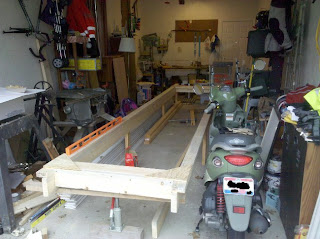I just stopped working. All the stations are lined up and true with the bottom. I was on a roll and tempted to secure the bottom board and start planing but: Despite the fact that it's hard to make big mistakes with hand tools I did have a lot of wine at dinner and I decided I should wait. If you saw the typos in the first draft of this post you would agree that it was the right decision. I will place my order for fasteners this week, Woo-hoo! Hamilton Marine sells by the each, saving me more than 50% when compared to Jamestown Distributors. Jamestown has lower prices, but you have to buy the whole box. On a boat this small that is just not practical.
I was concerned about how I would secure the bottom board for planing it's edge. I dreamed up different saw-horse configurations with sandbag ballast to limit vibration. When it was time to do the work I set a couple of clamps on one end of my bench (since it doesn't have a vise yet) and clamped a temporary support to one end of the building jig. It worked perfectly. No cost, no permanent fixtures to store, and no chatter. I was super cautious on the first side, approaching the line in tiny increments. When I flipped the panel to do the other side I took a full turn on my Bailey #5 to get more aggressive and cut 75% off of my time.
Once again my images are AWOL. I'll publish without them if I can't locate them this week.
I was concerned about how I would secure the bottom board for planing it's edge. I dreamed up different saw-horse configurations with sandbag ballast to limit vibration. When it was time to do the work I set a couple of clamps on one end of my bench (since it doesn't have a vise yet) and clamped a temporary support to one end of the building jig. It worked perfectly. No cost, no permanent fixtures to store, and no chatter. I was super cautious on the first side, approaching the line in tiny increments. When I flipped the panel to do the other side I took a full turn on my Bailey #5 to get more aggressive and cut 75% off of my time.
Once again my images are AWOL. I'll publish without them if I can't locate them this week.








